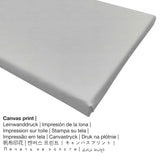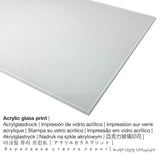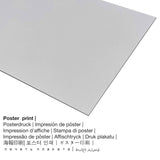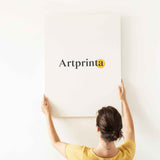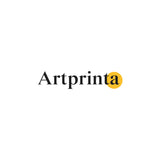Winslow Homer, 1871 - Ụbọchị mmiri ozuzo na Camp - mbipụta nka mara mma
Ụtụ gụnyere. Mbupu gbakọrọ na ndenye ọpụpụ.
Họrọ nhọrọ akụrụngwa gị
Maka mbipụta nka ọ bụla anyị na-enye ihe dị iche iche & nha dị iche iche. Anyị na-ahapụ gị ka ịhọrọ nha na akụrụngwa ọkacha mmasị gị n'etiti nhọrọ nhazi ngwaahịa ndị a:
- Mbipụta enyo acrylic: A glossy acrylic glass print, which is often described as a UV print on plexiglass, makes the original artwork into décor and offers a viable alternative option to canvas and dibond art prints. The artwork is being manufactured with the help of state-of-the-art UV direct printing machines. The major advantage of a plexiglass art print is that sharp contrasts and also color details will be more recognizeable with the help of the very subtle tonal gradation.
- Aluminom dibond mbipụta (ọla): An Aluminium Dibond print is a print with a true depth effect. Its non-reflective surface structure creates a modern look.
- Kwaaji: The canvas direct print is a printed canvas stretched on a wooden stretcher. A canvas produces a typical effect of three-dimensionality. Your printed canvas of your favorite work of art will provide you with the chance to turn your new art print into a large size work of art as you know from galleries. A canvas print has the great advantage of being relatively low in weight, meaning that it is quite simple to hang up your Canvas print without the use of extra wall-mounts. Hence, canvas prints are suitable for all types of walls.
- Bipụta akwụkwọ mmado n'ihe kwaaji: A poster print is a printed canvas paper with a slight texture on the surface, that resembles the original artwork. Please bear in mind, that depending on the size of the poster print we add a white margin 2-6cm round about the artwork, which facilitates the framing with your custom frame.
Nkwupụta iwu: We try to describe the products as accurately as possible and to display them visually in our shop. At the same time, the pigments of the printing material and the print result might differ slightly from the representation on the monitor. Depending on your screen settings and the condition of the surface, colors can unfortunately not be printed 100% realistically. Given that our are printed and processed manually, there may as well be slight discrepancies in the motif's exact position and the size.
Nkọwa agbakwunyere dịka The Metropolitan Museum of Art nyere (© - The Metropolitan Museum of Art - www.metmuseum.org)
Homer completed this painting, his last major scene of life at the front, six years after the Civil War ended, using studies he had made during the siege of Yorktown, Virginia, in April and May 1862. The red cloverleaf above Homer’s name on the overturned barrel in the left foreground was the insignia of the First Division of the Second Corps of the Army of the Potomac, of which the Sixty-First New York Volunteer Infantry—the unit to which the painter was assigned—was a part. One critic remarked that the bedraggled mule at the right “tells the whole story” of the miserable conditions at Yorktown.
Nchịkọta nke eserese, nke nwere aha "Rainy Day in Camp"
Na narị afọ nke 19 a na-akpọ Rainy Day in Camp e sere ya American artist Winslow Homer in 1871. The original of the work of art has the size: 20 x 36 in (50,8 x 91,4 cm) and was crafted with oil on canvas. What is more, this artwork belongs to the The Metropolitan Museum of Art's art collection. With courtesy of The Metropolitan Museum of Art, New York, Gift of Mrs. William F. Milton, 1923 (nwere ikike: ngalaba ọha). : Onyinye nke Oriakụ William F. Milton, 1923. Na mgbakwunye na nke a, nhazi ahụ dị na odida obodo format ma nwee oke nke 16: 9, which implies that the length is 78% longer than the width. Winslow Homer was a male painter from United States, whose style can mainly be classified as Realism. The American painter lived for 74 afọ - a mụrụ n'afọ 1836 na Boston, Suffolk County, Massachusetts, United States wee nwụọ na 1910.
Nkọwa nka ahaziri
| Aha nka nka: | "Rainy Day in Camp" |
| Nhazi nka: | sere |
| Nhazi nka: | nkà nke oge a |
| Nhazi oge: | 19th narị afọ |
| Afọ nka: | 1871 |
| Afọ nka: | ihe dị ka afọ 140 |
| Usoro izizi: | mmanụ na kwaaji |
| Akụkụ izizi nka: | 20 x 36 n'ime (50,8 x 91,4 cm) |
| Ụlọ ihe ngosi nka: | Museumlọ ihe ngosi nka nke Obodo |
| Ebe ebe ngosi nka: | New York City, New York, Njikota Obodo Amerika |
| Ibe weebụ: | Museumlọ ihe ngosi nka nke Obodo |
| Licensedị ikike: | ngalaba ọha |
| Site n'aka: | Ụlọ ihe ngosi nka nke Metropolitan, New York, Onyinye nke Oriakụ William F. Milton, 1923 |
| Ebe kredit nke ọrụ nka: | Onyinye nke Oriakụ William F. Milton, 1923 |
Tebụl edemede
| Nkewa ngwaahịa: | ọmarịcha nka |
| Usoro mmeghari: | dijitalụ mmeputakwa |
| Usoro mmepụta: | Mbipụta UV ozugbo (mbipụta dijitalụ) |
| Ihe ngosi: | German mere |
| Ụdị ngwaahịa: | na mmepụta ihe |
| Ihe eji eme atụmatụ: | ihe ndozi ụlọ, ụlọ mmepụta nka nka |
| Ndozi onyonyo a: | usoro odida obodo |
| Oke akụkụ onyonyo: | 16: 9 |
| Mmetụta akụkụ: | ogologo bụ 78% ogologo karịa obosara |
| Nhọrọ ihe: | mbipụta akwụkwọ mmado (akwụkwọ kwaaji), mbipụta kanvas, mbipụta enyo acrylic (nwere ezigbo mkpuchi iko), mbipụta ọla (aluminium dibbond) |
| Ọdịiche dị n'okirikiri akwa akwa akwa (akwa akwa): | 90x50cm - 35x20", 180x100cm - 71x39" |
| Mbipụta iko acrylic (nwere ezigbo mkpuchi iko) nhọrọ nha: | 90x50cm - 35x20", 180x100cm - 71x39" |
| Mbipụta akwụkwọ mmado (akwụkwọ kwaaji): | 90x50cm - 35x20" |
| Mbipụta aluminom (aluminium dibond ihe) nha dị iche iche: | 90x50cm - 35x20" |
| Igwe onyonyo: | biko mara na edeghị nnomi nka nka |
Ozi izugbe na onye na-ese ihe
| aha: | Winslow Homer |
| Aha ndi ozo: | w. homer, הומר וינסלאו, Homer, homer w., Homer Winslow, Winslow Homer |
| Gender: | nwoke |
| Obodo onye nka: | American |
| Ọrụ onye na-ese ihe: | onye na-ese ihe |
| Obodo obibi: | United States |
| Nhazi nke onye nka: | omenkà nke oge a |
| Ụdị nka: | Ihe ngosi |
| Oge ndu: | 74 afọ |
| Afọ amụrụ: | 1836 |
| Obodo: | Boston, Suffolk County, Massachusetts, Njikota Obodo Amerika |
| Afọ nwụrụ: | 1910 |
| Nwuru na (ebe): | Prouts Neck, Cumberland County, Maine, Njikota Obodo Amerika |
© Copyright - www.artprinta.com (Artprinta)


